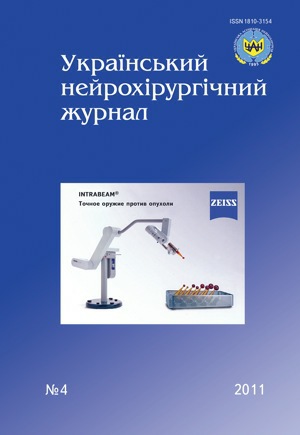Intracranial pressure monitoring during decompressive craniectomy in patients with severe traumatic brain injury
DOI:
https://doi.org/10.25305/unj.57562Keywords:
severe traumatic brain injury, intracranial pressure, brain edema, decompressive craniectomy, decompressive effect of operationAbstract
Prospective study was conducted at 75 injured persons with severe traumatic brain injury, who undergone intracranial pressure (ICP) monitoring during decompressive craniectomy (DC). In the beginning of operation an average ICP was (39±18.1) mm Hg, in the end of surgery performing — (15.8±12.4) mm Hg. DC with dura opening was found to be effective therapeutic method for ICP control. DC using the developed method promoted ICP reduction by (59.5±26.1)% in average in comparison with its preoperative level. Expedience of determination of decompressive effect of operation and its separate stages was grounded for surgery results prognosis.
References
Prat R. Prognostic factors in posttraumatic severe diffuse brain injury / R. Prat, V. Calatayud-Maldonado // Acta Neurochir. — 1998. — V.140. — P.1257–1261.
Smith R.R. Increased intracranial pressure and the cerebrospinal fluid spaces / R.R. Smith, K.S. Caldemeyer // Seminars Ultrasound CT MR. — 1996. — V.17. — P.206–220.
Effective ICP reduction by decompressive craniectomy in patients with severe traumatic brain injury treated by an ICP-targeted therapy / M. Olivecrona, M. Rodling-Wahlstrom, S. Naredi [et al.] // J. Neurotrauma. — 2007. — V.24, N6. — P.927–936.
Hutchinson P. Surgery for brain edema / P. Hutchinson, I. Timofeev, P. Kirpatrick // Neurosurg. Focus. — 2007. — V.22, N5. — P.1–9.
Декомпресивна гемікраніектомія в лікуванні гострої церебральної ішемії, ускладненої дислокаційним синдромом / М.Є. Поліщук, Г.В. Корюненко, А.О. Камінський [та ін.] // Укр. нейрохірург. журн. — 2003. — №1. — С.44–46.
Complications of cranioplasty following decompressive craniectomy: Analysis of 62 cases / M.R. Gooch,G.E. Gin, T.J. Kenning [et al.] // Neurosurg. Focus. — 2009. — V.26, N6. — P.1–7.
Ventricular pressure monitoring during bilateral decompression with dural expansion / Do-Sung Yoo, Dal-Soo Kim, Kyung-Suck Cho [et al.] // J. Neurosurg. — 1999. — V.91. — P.953–959.
Cучасні аспекти діагностики, лікування та профілактики внутрішньочерепної гіпертензії при тяжкій черепно-мозковій травмі: метод. рекомендації / Л.А. Дзяк, Є.Г. Педаченко, Ю.Ю. Кобеляцький [та ін.]. — К., 2010. — 16 с.
Пат. 54368 Україна, МПК А61В17/00. Спосіб декомпресивної трепанації черепа при патології головного мозку, що супроводжується підвищенням внутрішньочерепного тиску / Є.Г. Педаченко, Л.А. Дзяк, А.Г. Сірко; заявник і патентовласник ДУ “Інститут нейрохірургії ім. акад. А.П. Ромоданова АМН України». — №201004318; заявл. 13.04.10; опубл. 10.11.10. Бюл. №21.
Пат. 54363 Україна, МПК А61В17/00. Спосіб визначення декомпресивного ефекту операції при тяжкій черепно-мозковій травмі / Є.Г. Педаченко, Л.А. Дзяк, А.Г. Сірко, Сук В.М.; заявник і патентовласник ДУ «Інститут нейрохірургії ім. акад. А.П. Ромоданова АМН України». — №201004312; заявл. 13.04.10; опубл. 10.11.10. Бюл. №21.
Czosnyka M. Monitoring of cerebrospinal dynamics using continuous analysis of intracranial pressure and cerebral perfusion pressure in head injury / M. Czosnyka, D.J. Price, M. Williamson // Acta Neurochir. — 1994. — V.126. — P.113–119.
Rosner M.J. Cerebral perfusion pressure: management protocol and clinical result / M.J. Rosner, S.D. Rosner, A.H. Johnson // J. Neurosurg. — 1995. — V.83. — P.949–962.
Effect of mild hypothermia on uncontrollable intracranial hypertension after severehead injury / T. Shiozaki, H. Sugimoto, M. Taneda [et al.] // J. Neurosurg. — 1993. — V.79. — P.363–368.
Роль многокомпонентного нейромониторинга в лечении больных с внутричерепными кровоизлияниями / С.С. Петриков, В.В. Крылов, Х.Т. Гусейнова [и др.] // Вестн. интенсив. терапии. — 2010. — №4. — С.25–32.
Management of severe head injury: institutional variations in care and effect on outcome / E.M. Bulger, A.B. Nathens, F.P. Rivara [et al.] // Crit. Care Med. — 2002. — V.30. — P.1870–1876.
Specialist neurocritical care and outcome from head injury / H.C. Patel, D.K. Menon, S. Tebbs [et al.] // Intens. Care Med. — 2002. — V.28. — P.547–553.
Treatment of right hemispheric cerebral infarction by hemicraniectomy / J.B. Delashaw, W.C. Broaddus, N.F. Kassel [et al.] // Stroke. — 1990. — V.21. — P.874–881.
Moody R.A. An evaluation of decompression in experimental head injury / R.A. Moody,S. Ruamsuke, S.F. Mullan // J. Neurosurg. — 1968. — V.29. — P.586–590.
Decompressive bifrontal craniectomy in the treatment of severe refractory posttraumatic cerebral edema / R.S. Polin, M.E. Shaffrey, C.A. Bogaev [et al.] // Neurosurgery. — 1997. — V.41. — P.84–94.
Hemicraniectomy in the management of acute subdural hematoma / J. Ransohoff, M.V. Benjamin, E.L. Gage [et al.]// J. Neurosurg. — 1971. — V.34. — P.70–76.
Brain tissue pressure gradients created by expanding frontal epidural mass lesion / C.E. Wolfla, T.G. Luerssen, R.M. Bowman [et al.] // J. Neurosurg. — 1996. — V.84. — P.642–647.
Wolfla C.E. Brain tissue pressure gradients created by expanding extradural temporal mass lesion / C.E. Wolfla, T.G. Luerssen, R.M. Bowman // J. Neurosurg. — 1997. — V.86. — P.505–510.
Ivamoto H.S. Surgical decompression for cerebral and cerebellar infarcts / H.S. Ivamoto, M. Numoto, R.M. Donaghy // Stroke. — 1974. — V.5. — P.365–370.
Downloads
Published
How to Cite
Issue
Section
License
Copyright (c) 2011 Eugene Pedachenko, Lyudmila Dzyak, Andriy Sirko

This work is licensed under a Creative Commons Attribution 4.0 International License.
Ukrainian Neurosurgical Journal abides by the CREATIVE COMMONS copyright rights and permissions for open access journals.
Authors, who are published in this Journal, agree to the following conditions:
1. The authors reserve the right to authorship of the work and pass the first publication right of this work to the Journal under the terms of Creative Commons Attribution License, which allows others to freely distribute the published research with the obligatory reference to the authors of the original work and the first publication of the work in this Journal.
2. The authors have the right to conclude separate supplement agreements that relate to non-exclusive work distribution in the form of which it has been published by the Journal (for example, to upload the work to the online storage of the Journal or publish it as part of a monograph), provided that the reference to the first publication of the work in this Journal is included.









